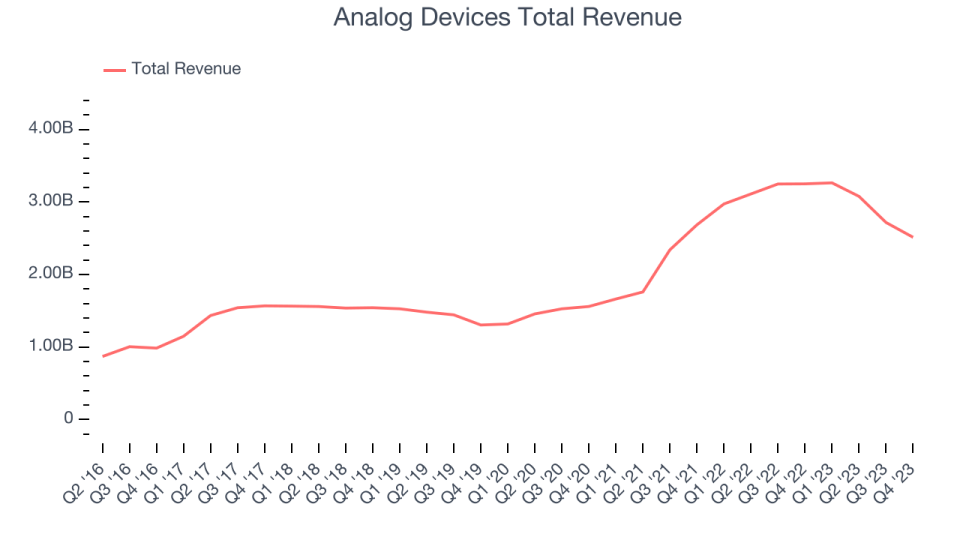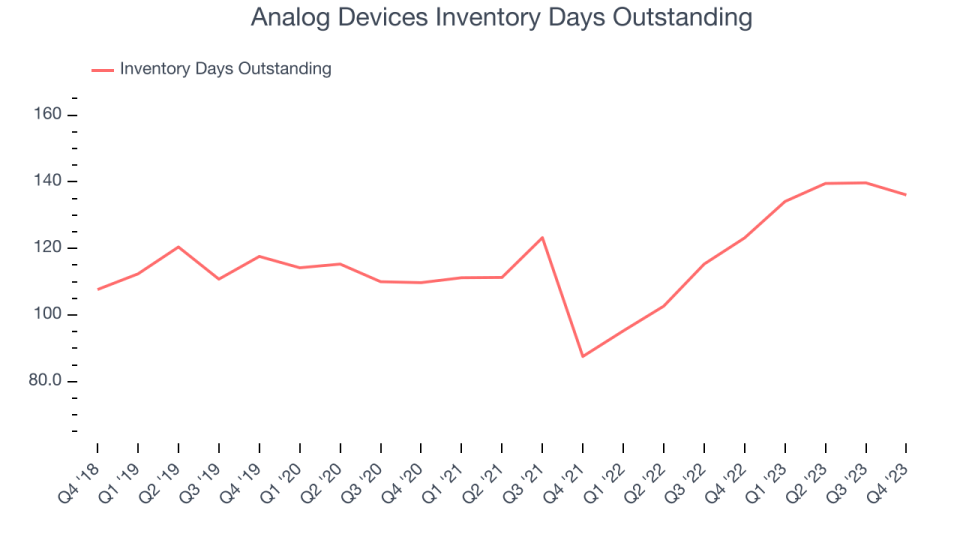No Surprises In Analog Devices's (NASDAQ:ADI) Q1 Sales Numbers But Quarterly Guidance Underwhelms

Manufacturer of analog chips, Analog Devices (NASDAQ:ADI) reported results in line with analysts' expectations in Q1 FY2024, with revenue down 22.7% year on year to $2.51 billion. On the other hand, next quarter's revenue guidance of $2.1 billion was less impressive, coming in 10.9% below analysts' estimates. It made a non-GAAP profit of $1.73 per share, down from its profit of $2.75 per share in the same quarter last year.
Is now the time to buy Analog Devices? Find out by accessing our full research report, it's free.
Analog Devices (ADI) Q1 FY2024 Highlights:
Revenue: $2.51 billion vs analyst estimates of $2.50 billion (small beat)
EPS (non-GAAP): $1.73 vs analyst estimates of $1.71 (1.4% beat)
Revenue Guidance for Q2 2024 is $2.1 billion at the midpoint, below analyst estimates of $2.36 billion
Free Cash Flow of $915.9 million, up 28.8% from the previous quarter
Inventory Days Outstanding: 136, down from 140 in the previous quarter
Gross Margin (GAAP): 58.7%, down from 65.4% in the same quarter last year
Market Capitalization: $93.91 billion
“ADI delivered first quarter revenue and profitability above the midpoint of our outlook, despite the continued difficult macroeconomic environment,” said Vincent Roche, CEO and Chair.
Founded by two MIT graduates, Ray Stata and Matthew Lorber in 1965, Analog Devices (NASDAQ:ADI) is one of the largest providers of high performance analog integrated circuits used mainly in industrial end markets, along with communications, autos, and consumer devices.
Analog Semiconductors
Demand for analog chips is generally linked to the overall level of economic growth, as analog chips serve as the building blocks of most electronic goods and equipment. Unlike digital chip designers, analog chip makers tend to produce the majority of their own chips, as analog chip production does not require expensive leading edge nodes. Less dependent on major secular growth drivers, analog product cycles are much longer, often 5-7 years.
Sales Growth
Analog Devices's revenue growth over the last three years has been strong, averaging 29.8% annually. But as you can see below, its revenue declined from $3.25 billion in the same quarter last year to $2.51 billion. Semiconductors are a cyclical industry, and long-term investors should be prepared for periods of high growth followed by periods of revenue contractions (which can sometimes offer opportune times to buy).

This was a slow quarter for the company as its revenue dropped 22.7% year on year, in line with analysts' estimates. This could mean that the current downcycle is deepening.
Analog Devices's revenue growth has decelerated over the last three quarters and its management team projects revenue to fall next quarter. As such, the company is guiding for a 35.6% year-on-year revenue decline while analysts are expecting a 11.7% drop over the next 12 months.
When a company has more cash than it knows what to do with, buying back its own shares can make a lot of sense–as long as the price is right. Luckily, we’ve found one, a low-priced stock that is gushing free cash flow AND buying back shares. Click here to claim your Special Free Report on a fallen angel growth story that is already recovering from a setback.
Product Demand & Outstanding Inventory
Days Inventory Outstanding (DIO) is an important metric for chipmakers, as it reflects a business' capital intensity and the cyclical nature of semiconductor supply and demand. In a tight supply environment, inventories tend to be stable, allowing chipmakers to exert pricing power. Steadily increasing DIO can be a warning sign that demand is weak, and if inventories continue to rise, the company may have to downsize production.

This quarter, Analog Devices's DIO came in at 136, which is 20 days above its five-year average. These numbers suggest that despite the recent decrease, the company's inventory levels are higher than what we've seen in the past.
Key Takeaways from Analog Devices's Q1 Results
It was encouraging to see Analog Devices beat analysts' revenue and EPS expectations this quarter, driven by better-than-expected performance in its automotive end market ($739 million of revenue vs estimates of $708 million). That result (+9% year-on-year growth for auto) was especially encouraging given the pessimism surrounding the auto sector to begin 2024. We were also glad the company's inventory levels shrunk.
On the other hand, Analog Devices's revenue guidance for next quarter missed analysts' expectations and its gross margin shrunk. It does, however, expect demand to pick back up in the second half of 2024 with management stating:
"We expect customer inventory rationalization to largely subside in our second quarter, and thus enter the second half in a more favorable business backdrop."
Lastly, the Board declared a quarterly cash dividend of $0.92 per outstanding share of common stock. The dividend will be paid on March 15, 2024 to all shareholders of record on March 5, 2024.
Overall, this was a mixed quarter for Analog Devices. The company is down 2.3% on the results and currently trades at $185.15 per share.
Analog Devices may have had a tough quarter, but does that actually create an opportunity to invest right now? When making that decision, it's important to consider its valuation, business qualities, as well as what has happened in the latest quarter. We cover that in our actionable full research report which you can read here, it's free.
